1993 BUICK RIVIERA horn
[x] Cancel search: hornPage 14 of 324
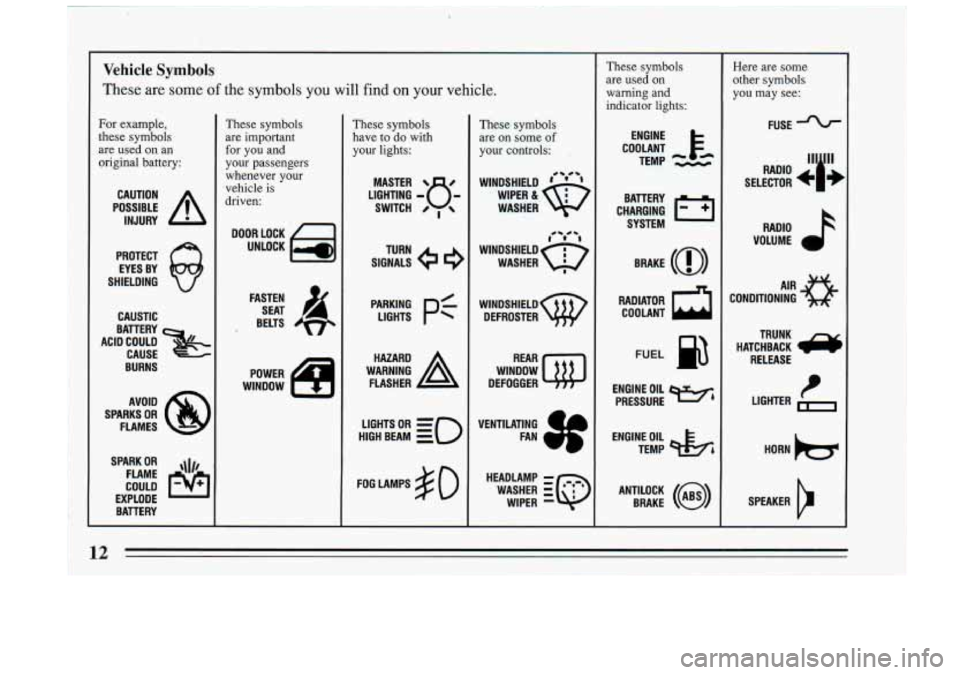
Vehicle Symbols
These are some of the symbols you will find on your vehicle.
For example,
these symbols
are used on an
original battery:
POSSIBLE A
CAUTION
INJURY
PROTECT EYES BY
SHIELDING
CAUSTIC
BURNS AVOID
SPARKS
OR
FLAMES
SPARK
OR ,111,
COULD pq
FLAME
EXPLODE BATTERY
These symbols
are important
for you and
your passengers whenever your
vehicle
is
driven:
FASTEN SEAT 4
BELTS
These symbols
have to do with
your lights:
SIGNALS TURN
HIGH BEAM
OR = =o
FOG LAMPS $0
These symbols
are on some
of
your controls:
WINDSHIELD ’ ’ ’ 4- #-
WASHER
f0 -**
WINDSHIELD Q
WASHER I
WINDSHIELD
DEFROSTER
WINDOW
DEFOGGER
VENTILATING
FAN
L.
HEADLAMP - ,~*-,
WASHER iQ
WIPER -
L
These symbols
are used on
warning and
indicator lights:
COOLANT F-
TEMP --
ENGINE
CHARGING
I-1
BATTERY SYSTEM
RADIATOR
a
COOLANT
FUEL
ENGINE OIL
PRESSURE
Wb
TEMP OIL &
ANTILOCK (@)
BRAKE
Here are some
other symbols
you may see:
FUSE
RADIO
‘‘ill
SELECTOR
RADIO
k
VOLUME
CONDITIONING
AIR 33
HATCHBACK /y
TRUNK
RELEASE
t LIGHTER 1-
HORN
SPEAKER
cr
~ 12 , .
Page 69 of 324
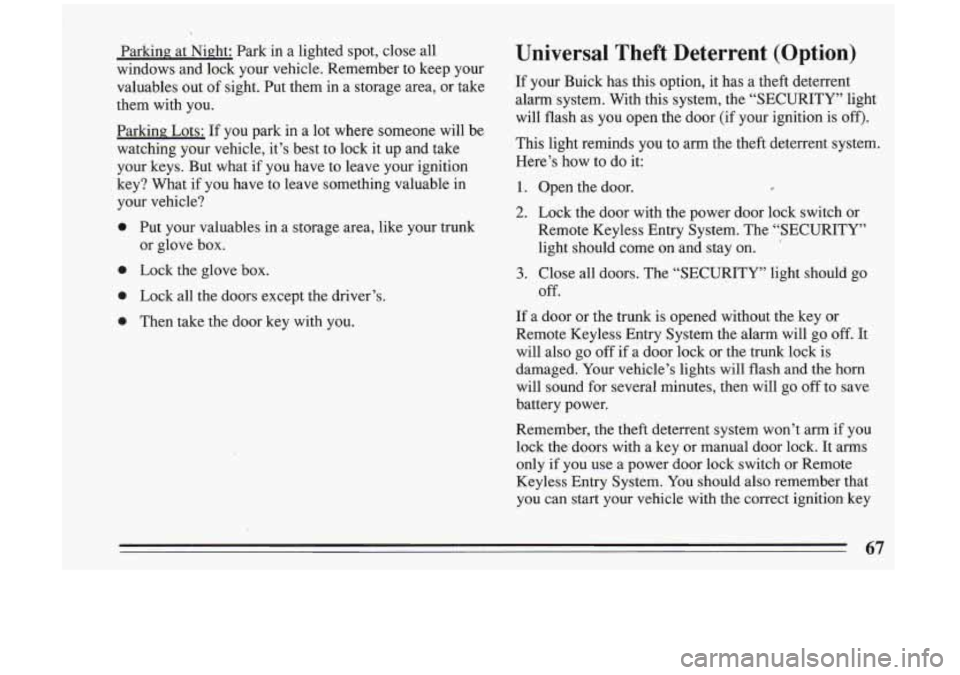
Parking at Night: Park in a lighted spot, close all
windows and lock your vehicle. Remember to keep your
valuables out of sight. Put them in a storage area, or take
them with you.
Parking Lots: If
you park in a lot where someone will be
watching your vehicle, it’s best to lock it up and take
your keys. But what if you have to leave your ignition
key? What if you have to leave something valuable in
your vehicle?
0
0
0
0
Put your valuables in a storage area, like your trunk
or glove box.
Lock the glove box.
Lock all the doors except the driver’s.
Then take the door key with you.
Universal Theft Deterrent (Option)
If your Buick has this option, it has a theft deterrent
alarm system. With this system, the “SECURITY” light
will flash as you open the door (if your ignition is
off).
This light reminds you to arm the theft deterrent system.
Here’s how to do it:
1.
2.
3.
Open the door.
Lock the door with the power door lock switch or
Remote Keyless Entry System. The “SECURITY”
light should come on and stay on.
Close all doors. The “SECURITY” light ‘should go
off.
If a door or the trunk is opened without the key or
Remote Keyless Entry System the alarm will go off. It
will also go off
if a door lock or the trunk lock is
damaged. Your vehicle’s lights will flash and the horn
will sound for several minutes, then will go
off to save
battery power.
Remember, the theft deterrent system won’t arm if you lock the doors with a key or manual door lock. It arms
only
if you use a power door lock switch or Remote
Keyless Entry System. You should also remember that
you can start your vehicle with the correct ignition key
67
Page 70 of 324
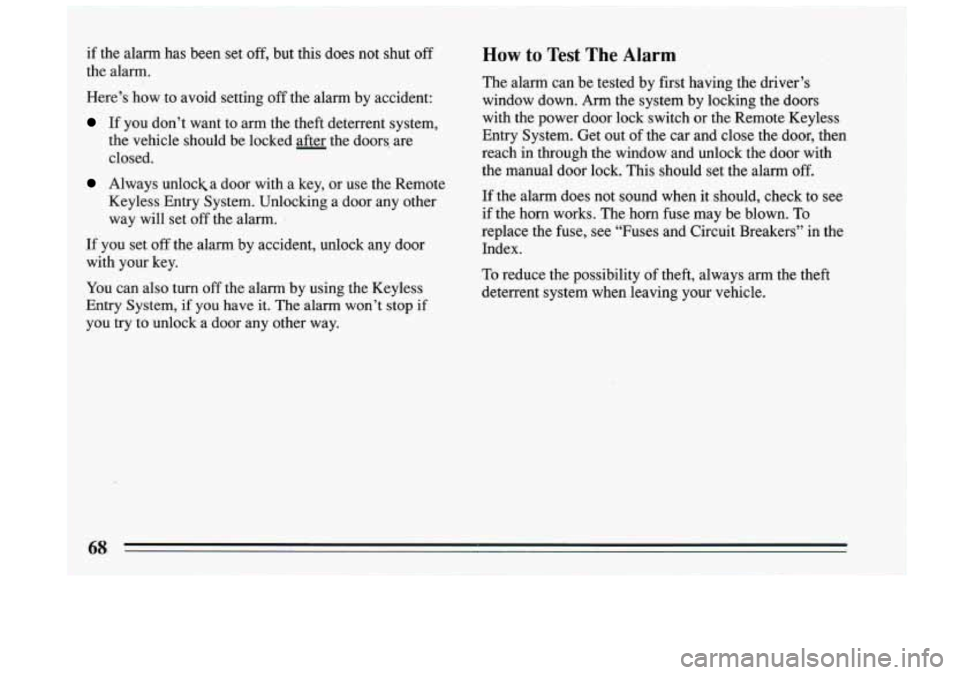
if the alarm has been set off, but this does not shut off
the alarm.
Here’s how to avoid setting off the alarm by accident:
If you don’t want to arm the theft deterrent system,
the vehicle should be locked after the doors, are
closed.
Always unlocks door with a key, or use the Remote
Keyless Entry System. Unlocking a door any other way will set
off the alarm.
If you set
off the alarm by accident, unlock any door
with your key.
You can also turn
off the alarm by using the Keyless
Entry System, if
you have it. The alarm won’t stop if
you try to unlock a door any other way.
How to Test The Alarm
The alarm can be tested by first having the driver’s
window down. Arm the system by locking the
doors
with the power door lock switch or the Remote Keyless
Entry System. Get out of the car and close the door, then
reach in through the window and unlock the door with
the manual door lock. This should set the alarm off.
If the alarm does not sound when it should, check to see
if the horn works. The horn fuse may be blown. To
replace the fuse, see “Fuses and Circuit Breakers” in the
Index.
To reduce the possibility of theft, always arm the theft
deterrent system when leaving your vehicle.
68
Page 86 of 324
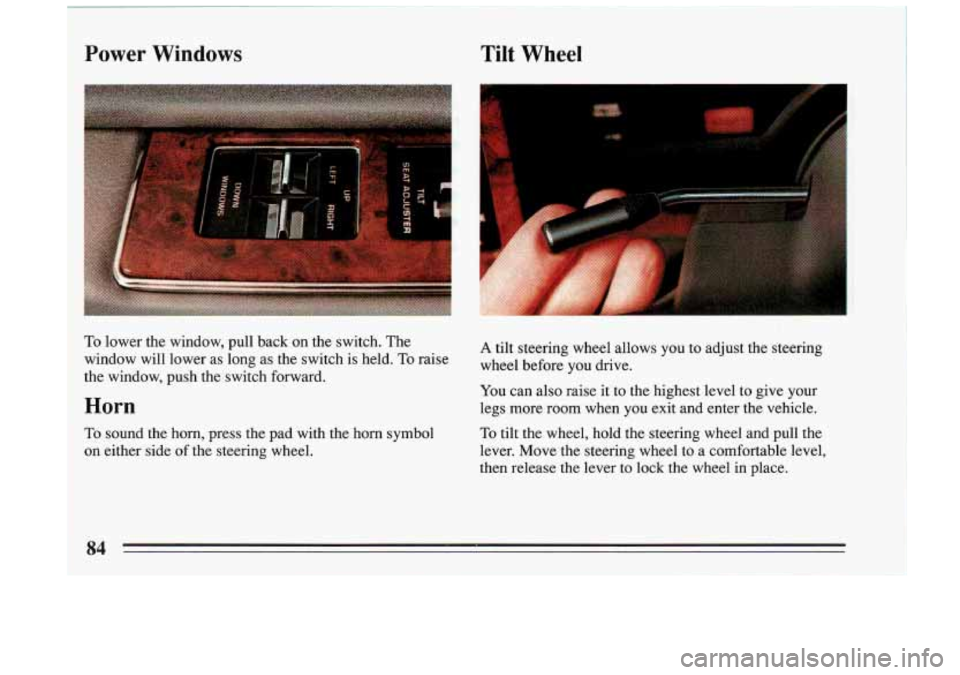
Power Windows
To lower the window, pull back on the switch. The
window will lower as long as the switch is held. To raise
the window, push the switch forward.
Horn
To sound the horn, press the pad with the horn symbol
on either side of the steering wheel.
A tilt steering wheel allows you to adjust the steering
wheel before you drive.
You can also raise it to the highest level to give your
legs more room when you exit and enter the vehicle.
To tilt the wheel, hold the steering wheel and pull the
lever. Move the steering wheel to
a comfortable level,
then release the lever to lock the wheel in place.
OA
Page 162 of 324
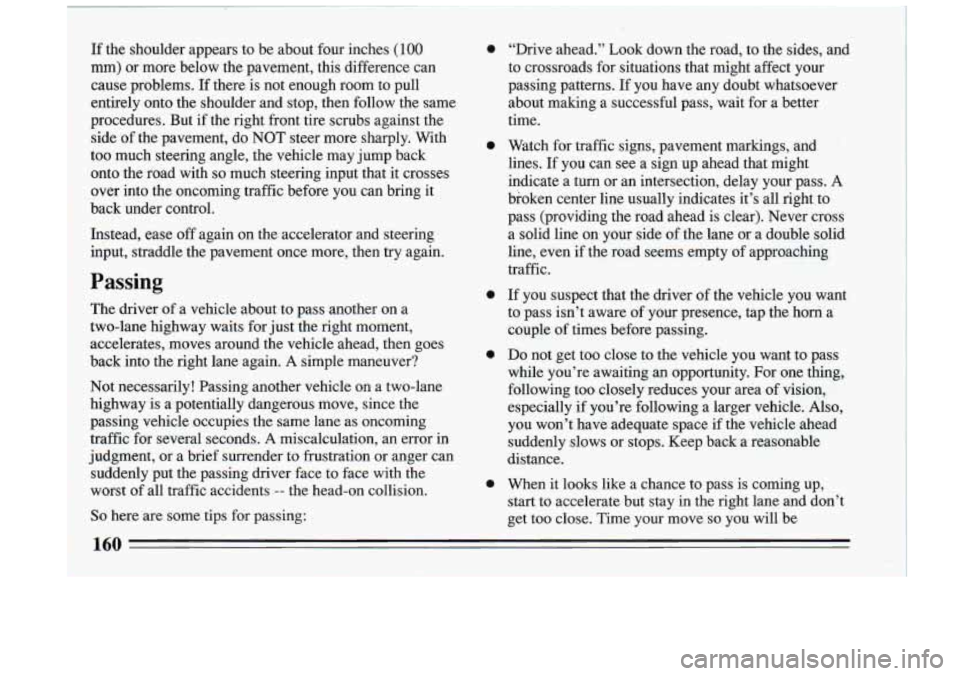
If the shoulder appears to be about four inches (100
mm) or more below the pavement, this difference can
cause problems.
If there is not enough room to pull
entirely onto the shoulder and stop, then follow the same
procedures. But if the right front tire scrubs against the
side of the pavement, do NOT steer more sharply. With
too much steering angle, the vehicle may jump back
onto the road with
so much steering input that it crosses
over into the oncoming traffic before you can bring it
back under control.
Instead, ease off again on the accelerator and steering
input, straddle the pavement once more, then try again.
Passing
The driver of a vehicle about to pass another on a
two-lane highway waits for just the right moment,
accelerates, moves around the vehicle ahead, then goes
back into the right lane again. A simple maneuver?
Not necessarily! Passing another vehicle on a two-lane
highway is a potentially dangerous move, since the
passing vehicle occupies the same lane as oncoming
traffic for several seconds. A miscalculation, an error
in
judgment, or a brief surrender to frustration or anger can
suddenly put the passing driver face to face with the
worst of all traffic accidents
-- the head-on collision.
So here are some tips for passing:
0
0
0
0
0
“Drive ahead.” Look down the road, to the sides, and
to crossroads for situations that might affect your
passing patterns. If you have any doubt whatsoever
about making a successful pass, wait for a better
time.
Watch for traffic signs, pavement markings, and
lines.
If you can see a sign up ahead that might
indicate a turn or an intersection, delay your pass.
A
broken center line usually indicates it’s all right to
pass (providing the road ahead
is clear). Never cross
a solid line on your side of the lane or a double solid
line, even
if the road seems empty of approaching
traffic.
If you suspect that the driver of the vehicle you want
to pass isn’t aware of your presence,, tap the
horn a
couple of times before passing.
Do not get too close to the vehiclc 3u want to pass
while you’re awaiting an opportunny. For one thing, following too closely reduces your area of vision,
especially
if you’re following a larger vehicle. Also,
you won’t have adequate space
if the vehicle ahead
suddenly slows
or stops. Keep back a reasonable
distance.
~~
When it looks like a chance to pass is coming up,
start to accelerate but stay in the right lane and don’t
get too close. Time your move
so you will be
160
Page 170 of 324
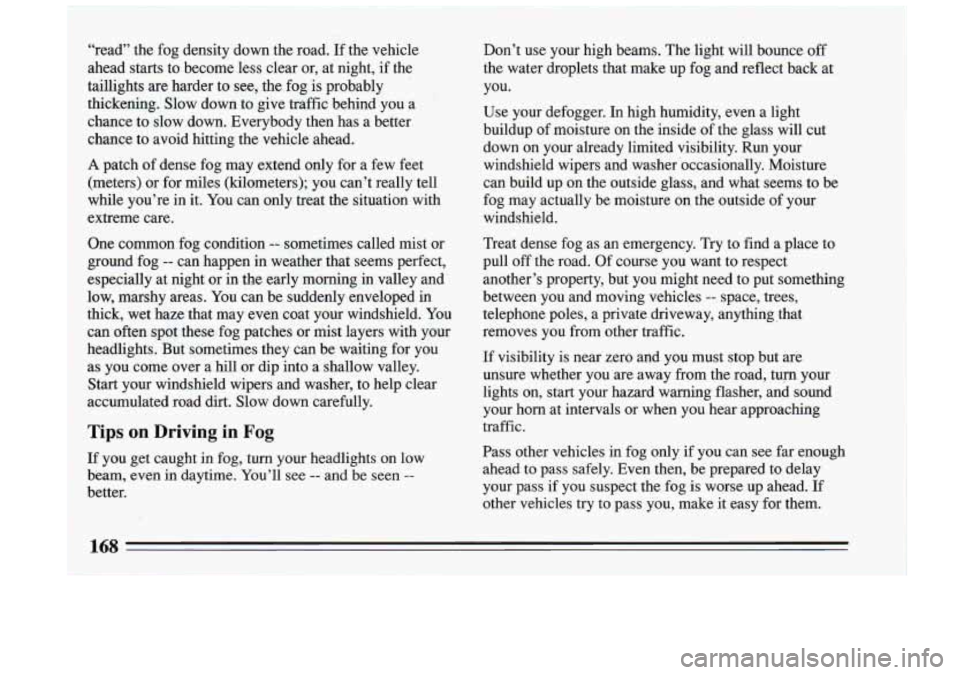
Don’t use your high beams. The light will bounce off
the water droplets that make up fog and reflect back at
you.
Use your defogger.
In high humidity, even a light
buildup of moisture on the inside of the glass will cut
down on your already limited visibility.
Run your
windshield wipers and washer ‘occasionally. Moisture
can build up on the outside glass, and what seems to be
fog may actually be moisture on the outside of your
windshield.
Treat dense fog as an emergency.
Try to find a place to
pull off the road. Of course you want to respect
another’s property, but you might need to put something
between you and moving vehicles
-- space, trees,
telephone poles, a private driveway, anything ,that
removes you from other traffic.
If visibility is near zero and you
must stop but are
unsure whether you are away from the road, tu_m your
lights on, start your hazard warning flasher, and sound your horn at intervals or when you hear approaching
traffic.
Pass other vehicles in fog only if you can see far enough
ahead to pass safely. Even then, be prepared to delay
your pass if you suspect the fog is worse up ahead.
If
other vehicles try to pass you, make it easy for them.
Page 304 of 324
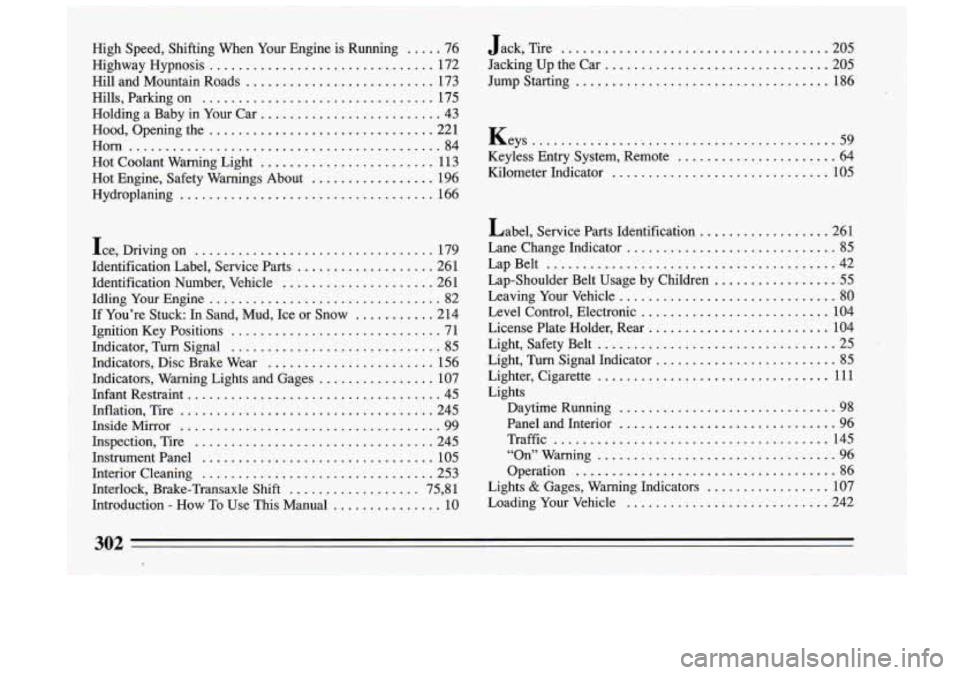
High Speed. Shifting When Your Engine is Running ..... 76 Jack. Tire ..................................... 205
Highway Hypnosis
............................... 172 Jacking Up the Car ............................... 205
Hill and Mountain Roads
.......................... 173 Jump Starting ................................... 186
Hills. Parking on
................................. 175
Holding a Baby in Your Car
......................... 43
Hood. Opening the
............................... 221
Horn ........................................... 84 Keys 59
Hot Coolant Warning Light
........................ 113 Keyless Entry System. Remote 64
Hydroplaning
................................... 166
..........................................
......................
Hot Engine. Safety Warnings About 196 Kilomefa- J&$q$cx .. +... .? . ... _. % ......... . ... .’_ rs.z7 t- ........ . 105 .................
Ice. Driving on ................................. 179
Identification Label. Service Parts
................... 261
Identification Number. Vehicle
..................... 261
Idling Your Engine
................................ 82
If You’re Stuck: In Sand. Mud. Ice or Snow
........... 214
Indicator. Turn Signal
............................. 85
Indicators. Disc Brake Wear ....................... 156
Indicators. Warning Lights and Gages
................ 107
Infant Restraint
................................... 45
Inflation. Tire
................................... 245
Inside Mirror
.................................... 99
Inspection. Tire
................................. 245
Instrument Panel
................................ 105
Interior Cleaning
................................ 253
Interlock. Brake-Transaxle Shift
.................. 75. 81
Introduction
. How To Use This Manual ............... 10
Ignition Key Positions
............................. 71
Label.
Service Parts Identification
.................. 261
Lane Change Indicator
............................. 85
Lap-Shoulder Belt Usage by Children
................. 55
Leaving Your Vehicle .............................. 80
Level Control. Electronic
.......................... 104
License Plate Holder. Rear
......................... 104
Light. Safety Belt
................................. -25
Light.
Turn Signal Indicator ......................... 85
Lighter. Cigarette
................................ 111
Lights Daytime Running
.............................. 98
Panel and Interior
.............................. 96
Traffic
...................................... 145
“On” Warning
................................. 96
Operation
.................................... 86
Loading Your Vehicle ............................ 242
Lap Belt
........................................ -42
Lights
& Gages. Warning Indicators ................. 107
302